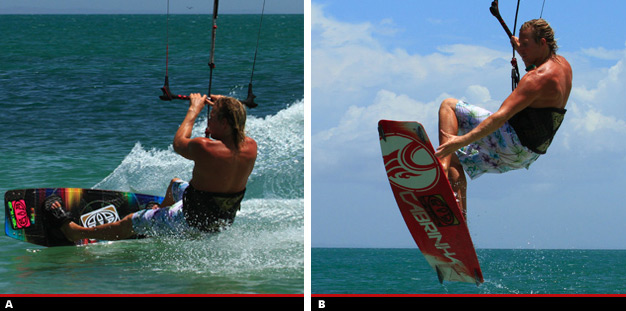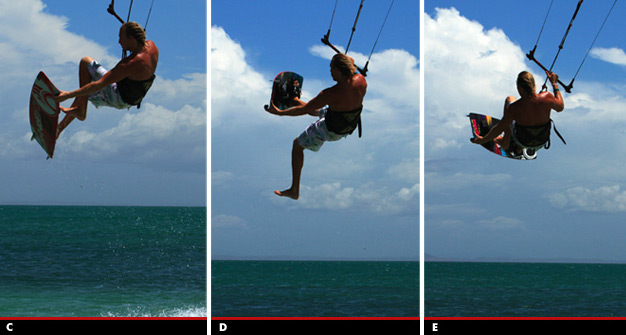Foot Air Gybe
Foot Air Gybe
We all like to show off now and then and sometimes the simplest of things look and feel good. The Foot Air Gybe is one of those tricks and besides a trick that you can learn without being afraid of ending up doing a face plant.
Before you start trying making a foot air gybe it’s recommended and somewhat taken for granted that you already master the air gybe. It´s also a bonus, but not a must, if you already have done your first one foot jump. The advantage of having done some one-foot jumps before is that you know the necessary movements to get your foot in out the foot strap and still land with control.
Before we go through the key parts of this move let’s make sure that you understand what the foot air gybe is all about. Coming into an air gybe you take of as usual, then release your front hand, grab the heelside edge of the board at the back of your front foot or wherever you find it comfortable, slip your foot out of the strap, before then turning to face the other way, replacing your foot and diving the kite and sailing off in the opposite direction.
Approach and take off
This part of the air gybe differs from that of a normal jump because you don’t want to be flying through the air at high speed. If you do you´ll end up pendulum under the kite and it will be very difficult to land and travel in the other direction.
In picture A you can see how you should carve up in preparation for the take off, similar to a jump. The difference is however that before you send the kite you have already carved up against the wind. By doing this you kill off any unwanted speed, so that when you jump you will only go up, not forward.
Also make sure that your back leg is quite bent so that you´re ready to go early and up as soon as the kite starts to lift. Finally be sure to put your hands close to the middle of the bar, so that you´ll be able to steer the kite with one hand.
You should still approach the air gybe on an edge and with some speed as you need power in the kite. The kite should be positioned at around 11 or 1 o’clock. Then carve hard into wind by looking over your front shoulder, twisting your hips upwind and pushing down on your back foot.
Even though you send the kite hard you need to pre-empt the take off rather than wait to be lifted up of the water. So once you have sent the kite, as soon as you feel it starts to lift, rather than resist more, jump up off your back foot to get in the air. As you do this you can then bring your hands to your hips, which not only gives you some extra lift but also brings the bar parallel with the water, which stops the kite flying too far past 12 o’clock.
Grab and Fly
In order to be able to reach the board with your hand you need to bring your front knee and foot up as soon as you take off. At the same time you need to maintain the float from the kite by keeping it above you, with tension in the back lines. This would be the same as getting into the big chill position of a normal air gybe, where you bring the knees up, pull the hands down and keep looking forward in the way that you were going.
In picture B you can see that the jumper has brought his front knee up so that the board is within easy reach. You can also notice that he hasn’t brought up his back leg as much, this way the board is angled up towards, making it easier to grab. He also looks at the point of the board where he intends to grab the board, which will make the process quicker. You can also see that he has his back hand right up close to the chicken loop. In this position you can pull down on the hand to keep the kite above you in the big chill position. The final thing to take notice off is the fact that the jumper has kept himself upright and has not rolled back to get his feet back.
If you roll back it’ll be hard to keep the bar in and hard to get your foot out, meaning that you´ll drop quicker and struggle to have the time for any fancy footwork.
Slipping Out
The simplest way to get your foot out from the strap is to push the board away from you, so that your arm is doing most of the work. The benefit of watching your foot also enables you to keep looking forward, which is one of the most crucial ingredients for a good air gybe.
In picture C you´ll see that the rider has pushed the board away from his foot by extending his arm. At the same time he pulls his foot back towards his bum and bingo, out slips his foot. At first this is all you should aim for, a quick out and in. If you look at his bar you can see that the bar is still pulled in, so the kite is still supporting him even though it has drifted slightly past 12 o’clock.
Hang Time
Once you have confidence you can go for a bit more extension, just to make sure that everyone and anyone can see that you’ve ditched the foot. As long as you have the bar in and the kite is still relatively above you, you’ll be supported and have time for such showmanship. Keep your board arm extended as this will make getting your foot back in easier.
To increase awareness of this move you can see in picture D that the rider has straightened his leg. Much like a 1 footed jump if you try and push your leg down towards the water it will straighten easily.
Putting your foot in it
Throughout this move, unless you’ve been trying to stare into a camera lens or catch the eye of someone special, you’ve most likely been staring at your hand and the footstrap. By looking this way it will help to stop you drifting the kite too much behind you and it will make sticking your foot back in a synch. Use your hand and arm to pull the board back onto your foot.
That said if you look at picture E you can see that the riders kite is certainly starting to drop the other way. However because he has kept the bar in the kite will pull rather than flutter down the edge of the window. When you feel the kite start to pull from the other side it is a warning that you need to get your foot back in and you need to dive the kite hard to pull you out of the trick.
As soon as you feel that your back foot is going into the strap, start to pull on your bar hand hard to dive the kite.
Touch Down
Now just like landing anything your aim is to get power in the kite so that it’ll pull you down wind, enabling you to land on a float board, off the wind and with some speed.
Tips
As always before performing a new trick, refresh your body memory by making a few good air gybes in preparation for the one foot air gybe. Once you’re comfortable with the air gybe move on to some grabbed air gybes and finally slip out your foot. One good thing is to wiggle your foot a bit before you settle in for the foot air gybe, just to make sure that you can easily slip out when it’s time.
Good Luck!

